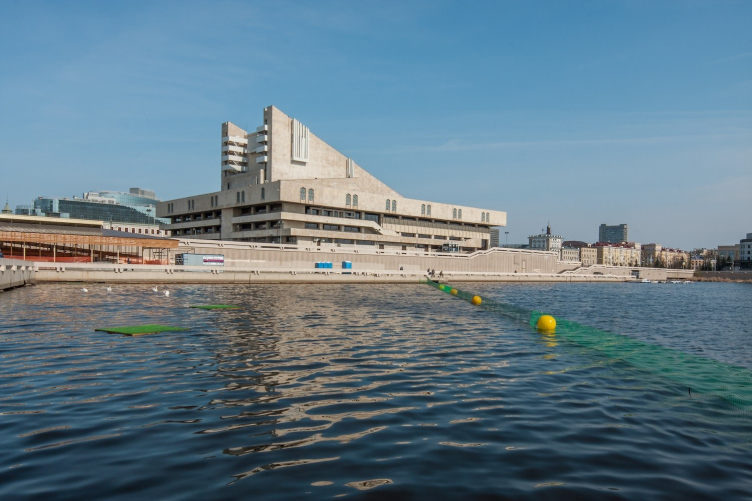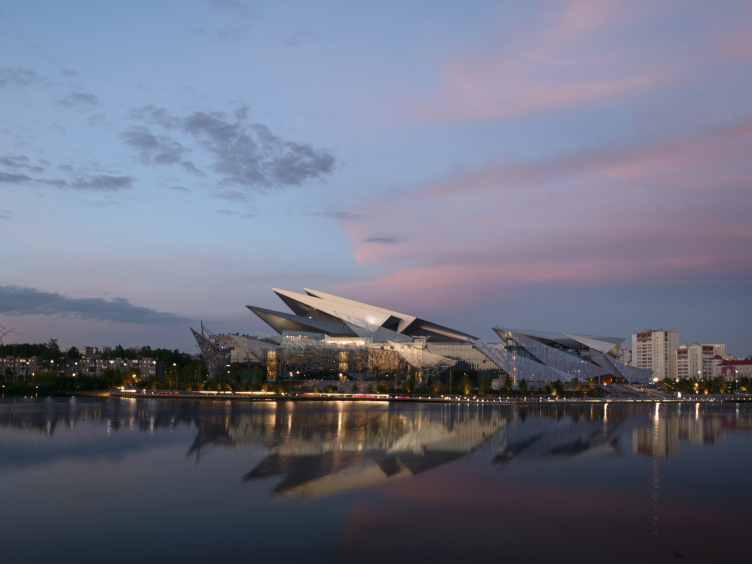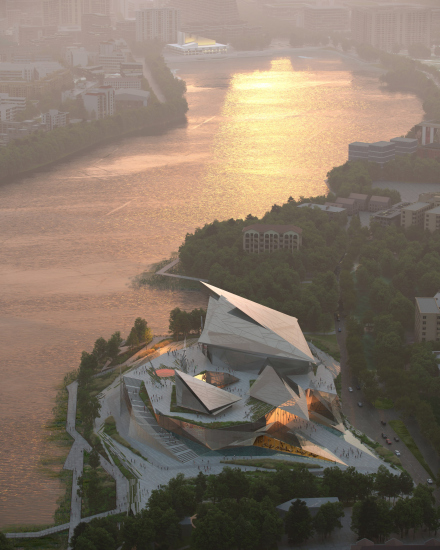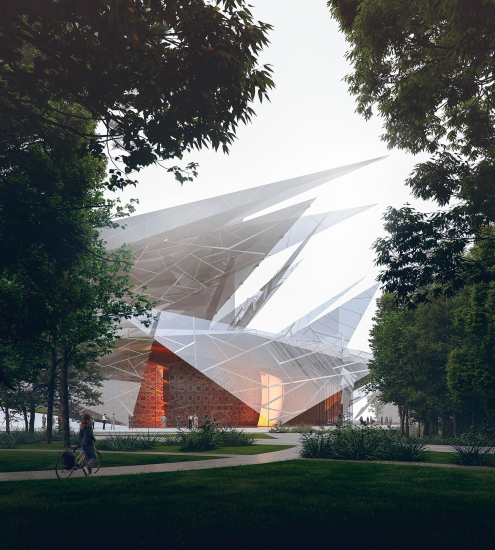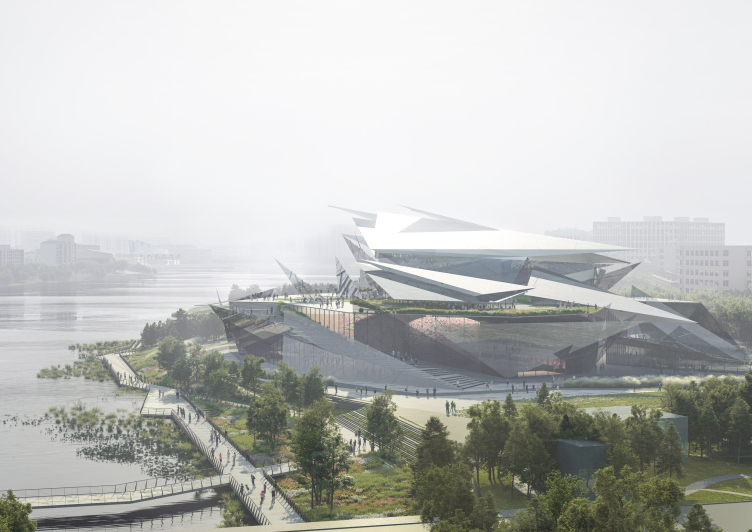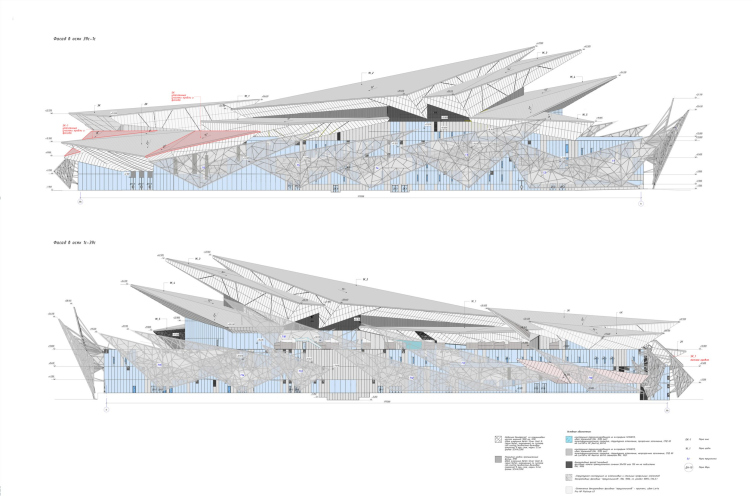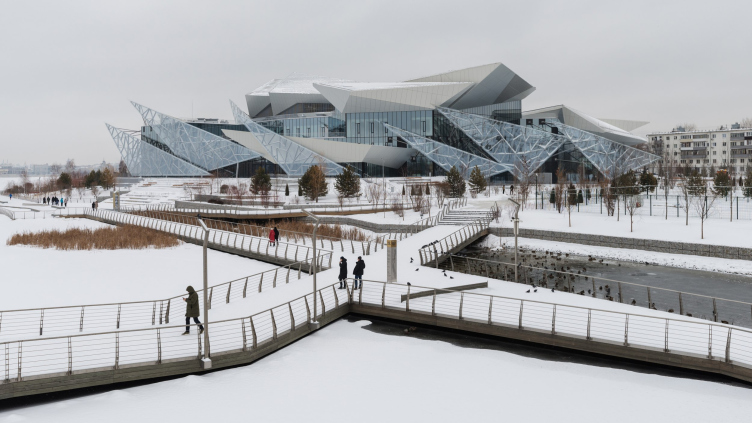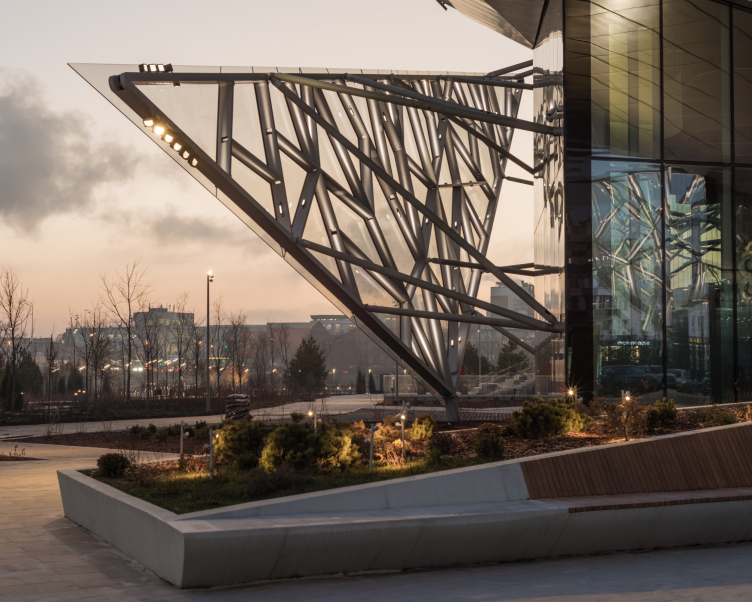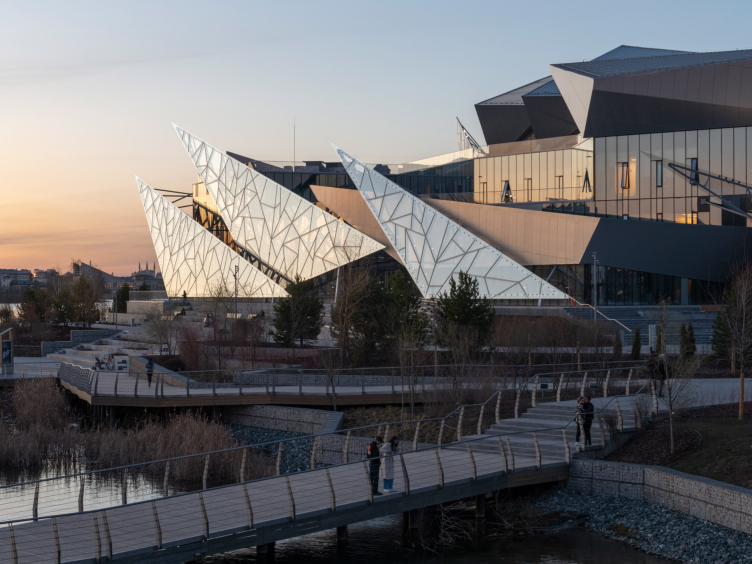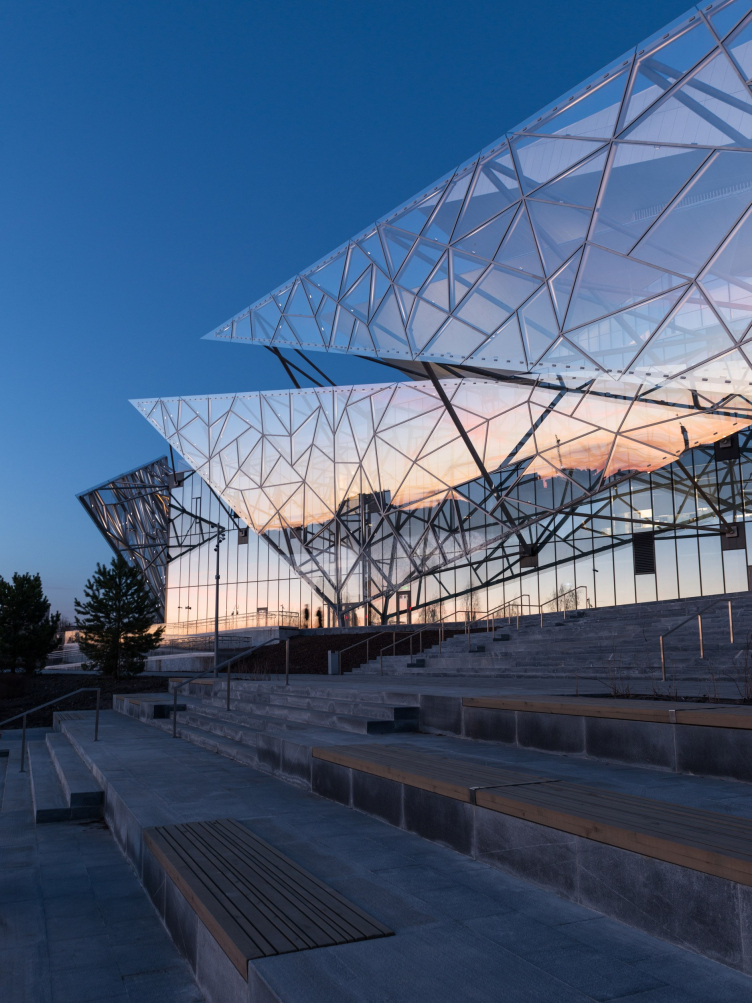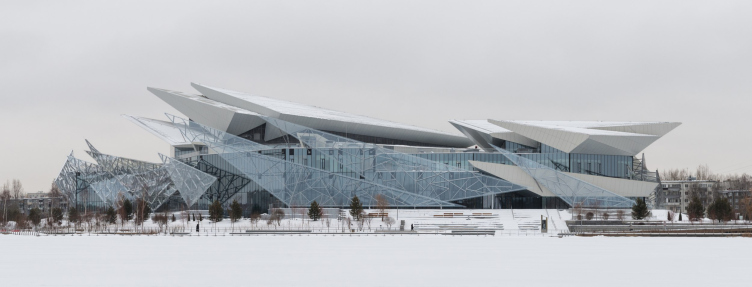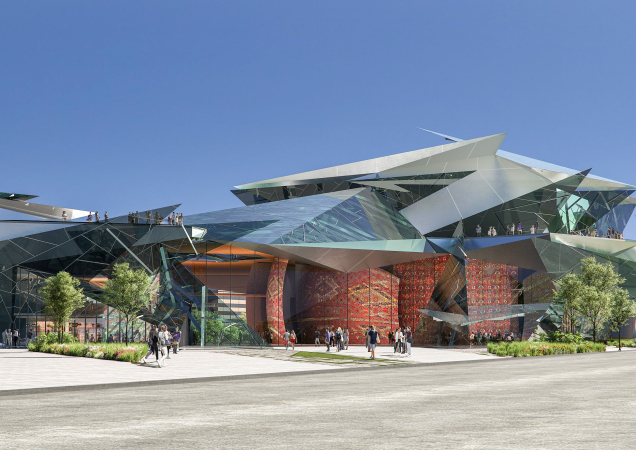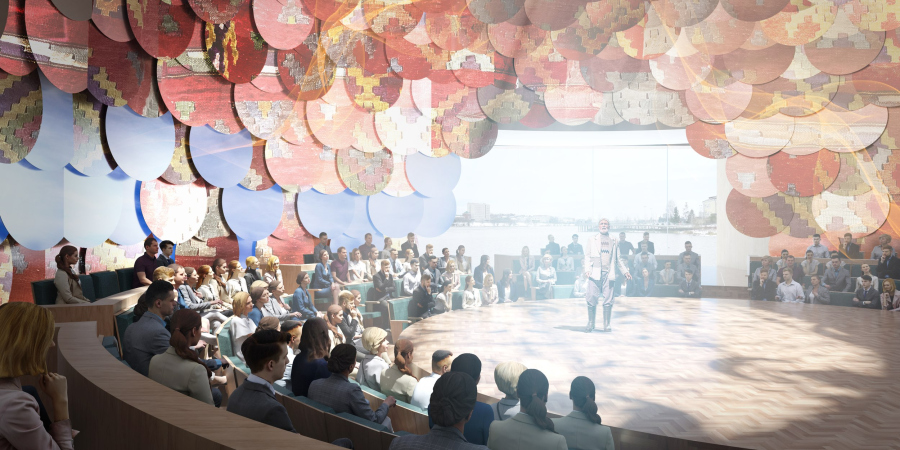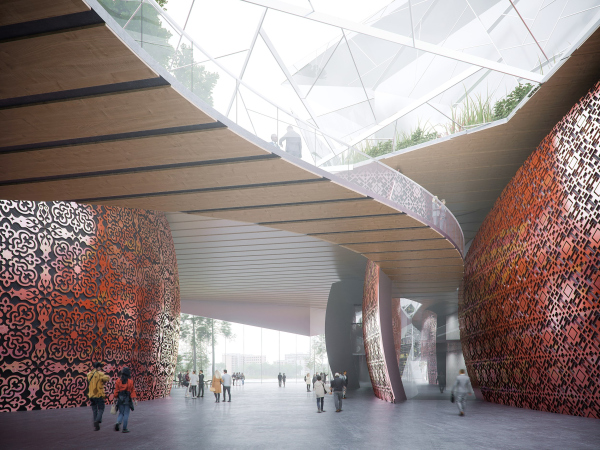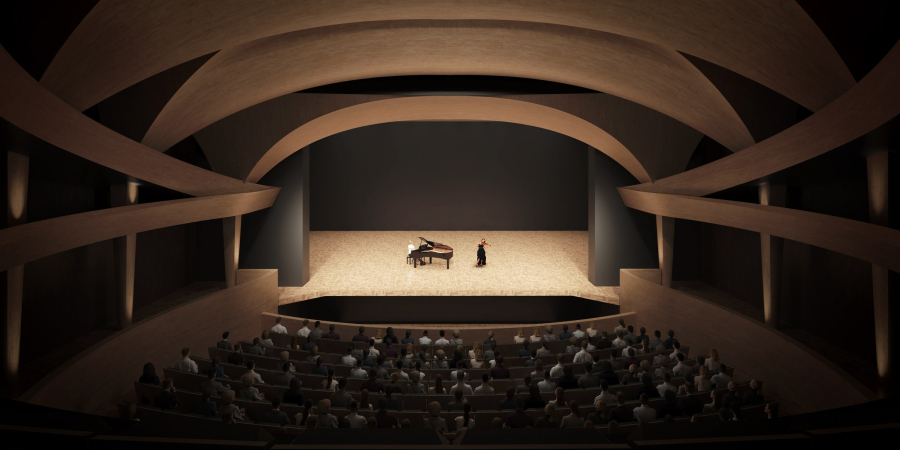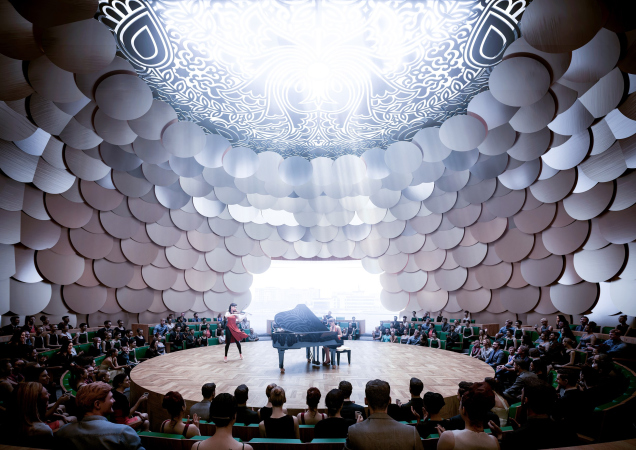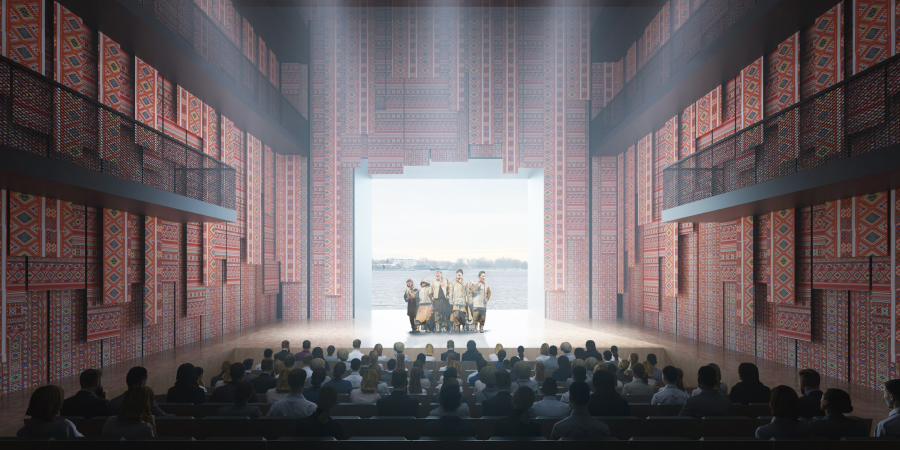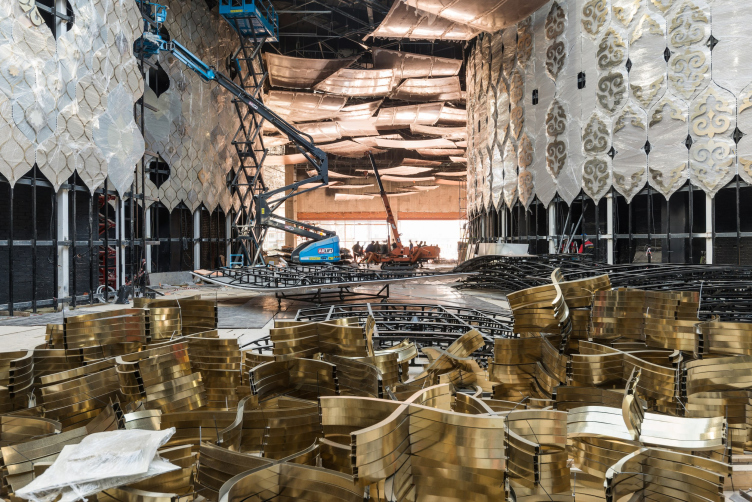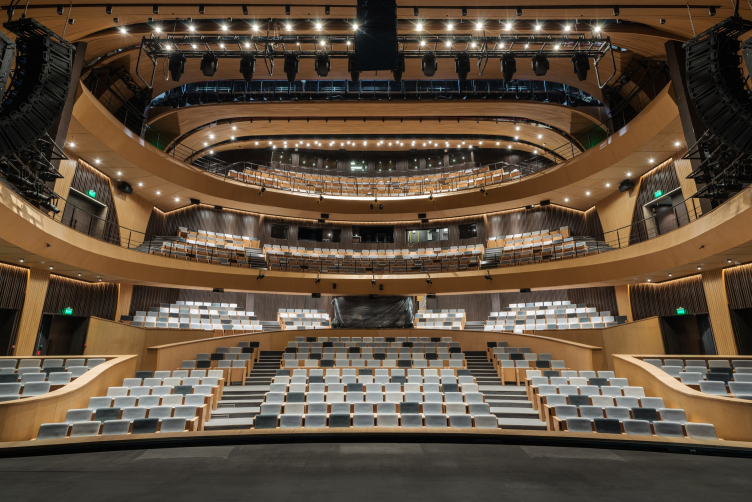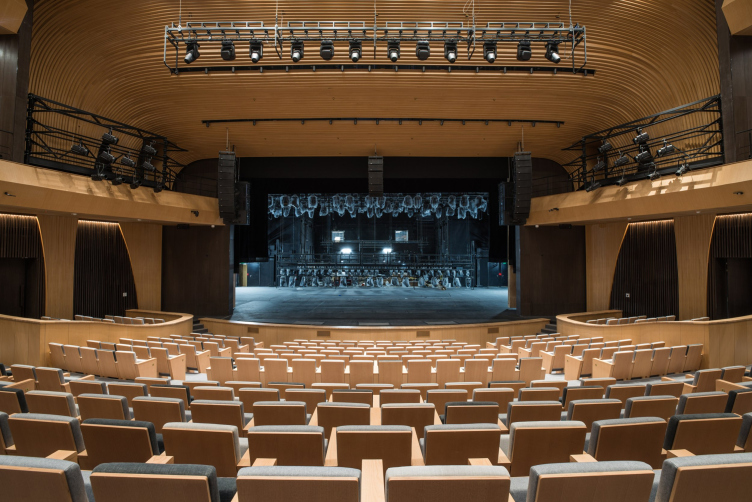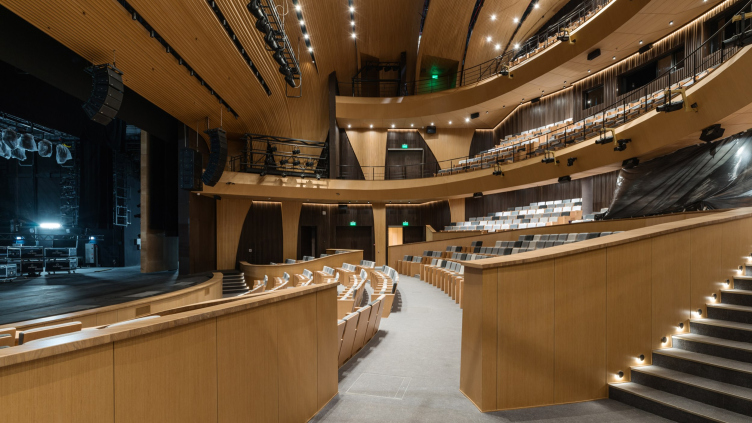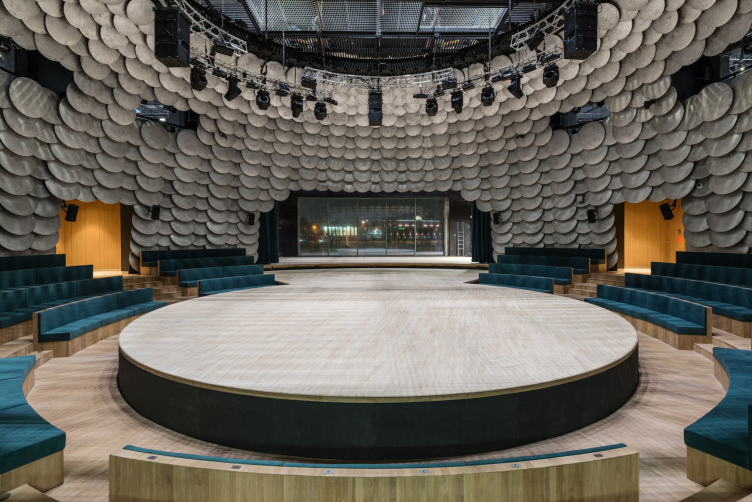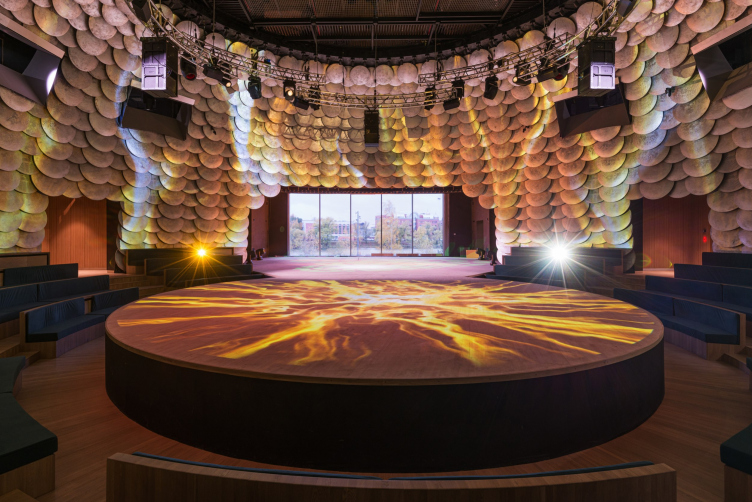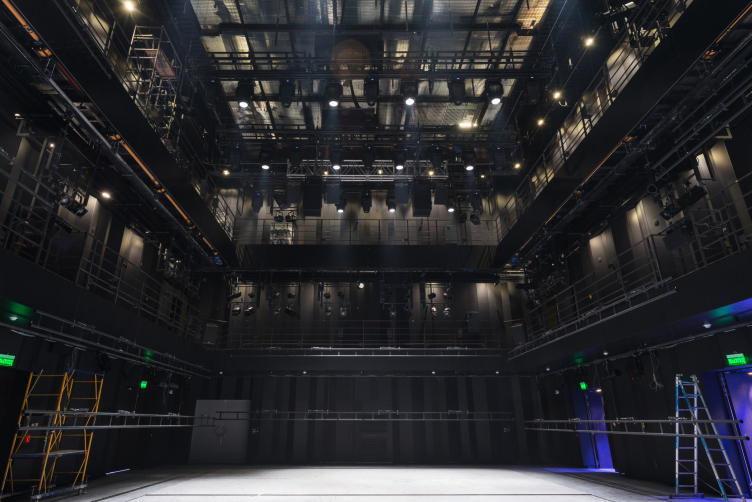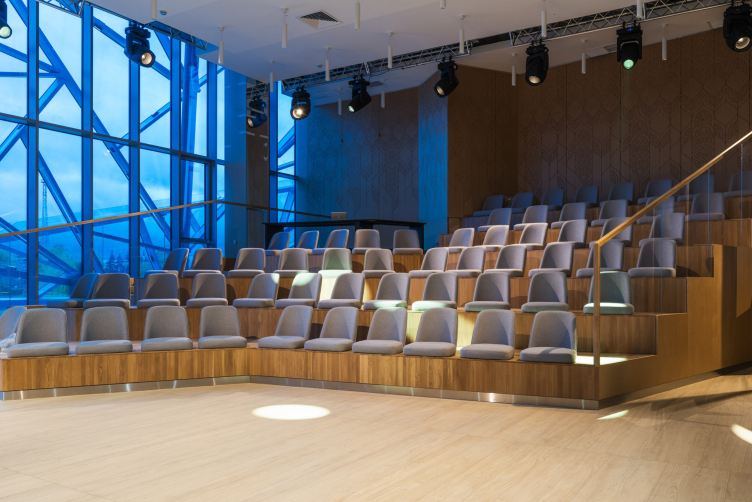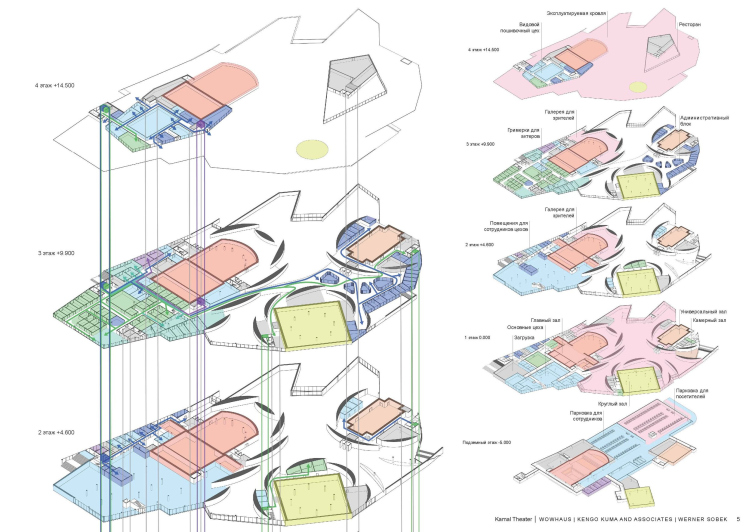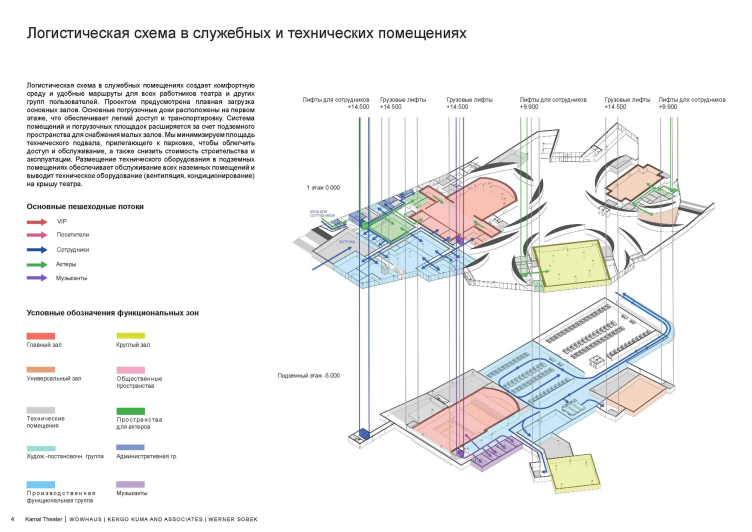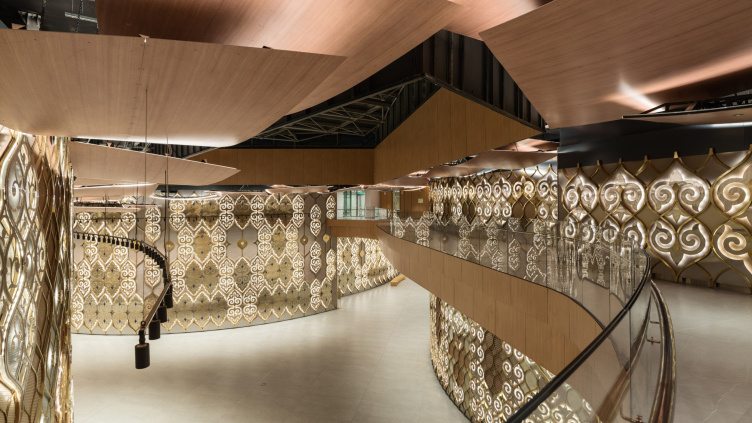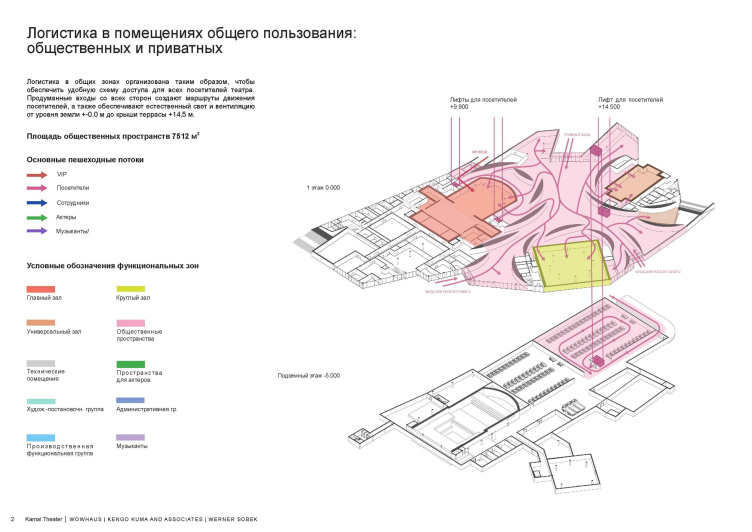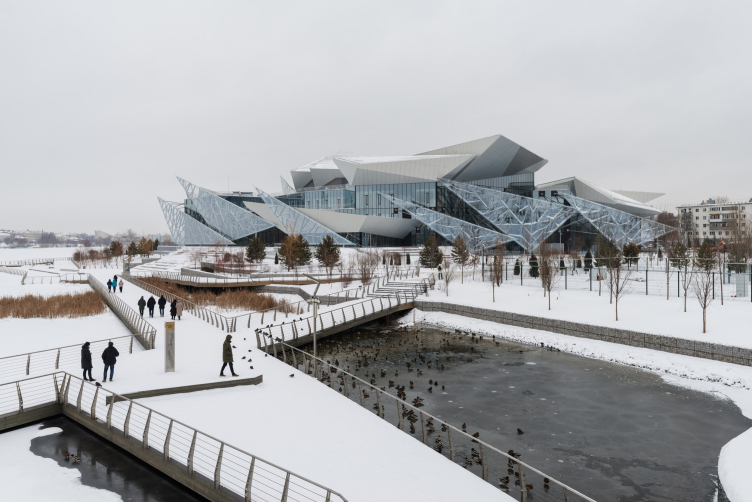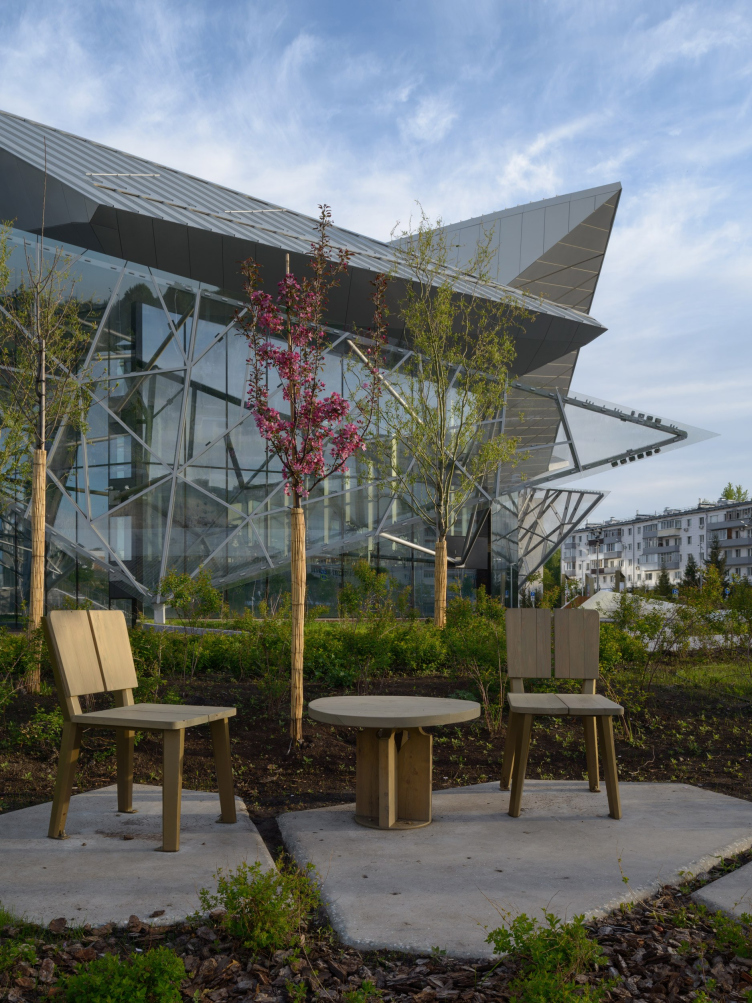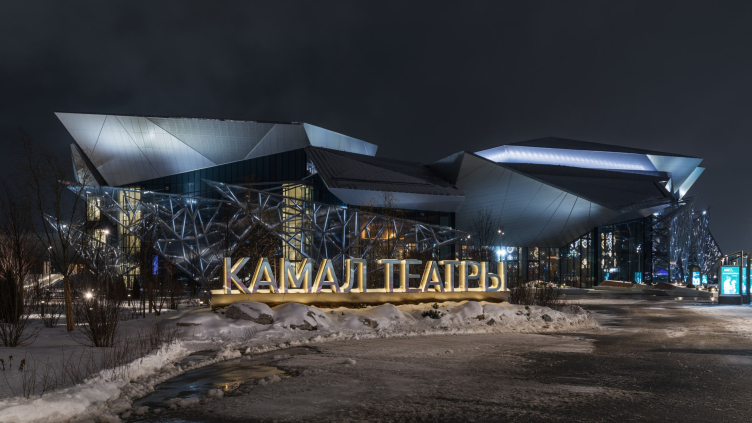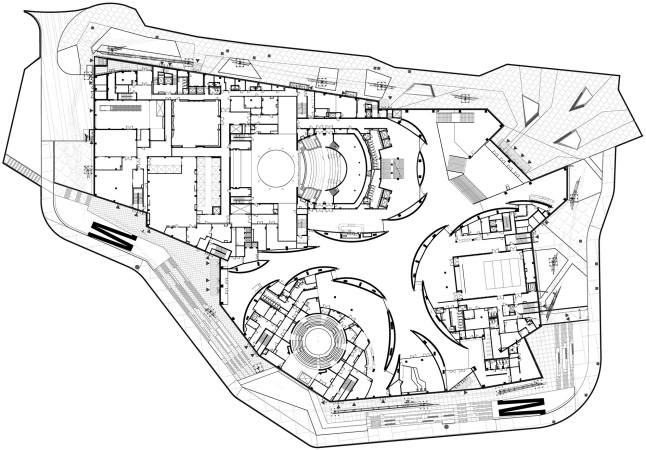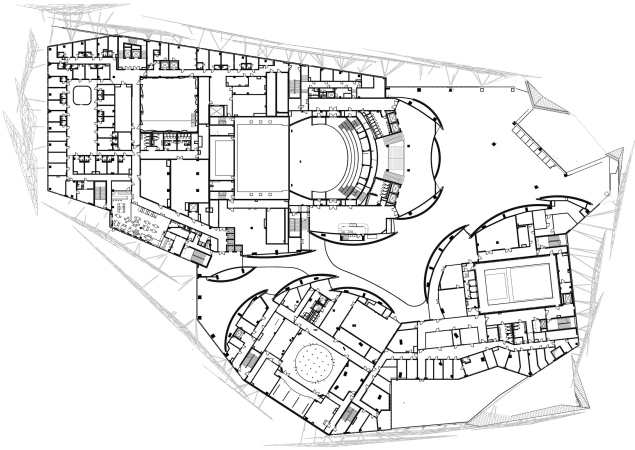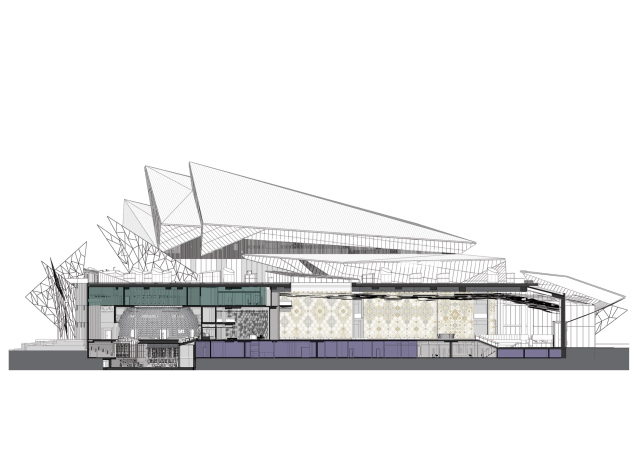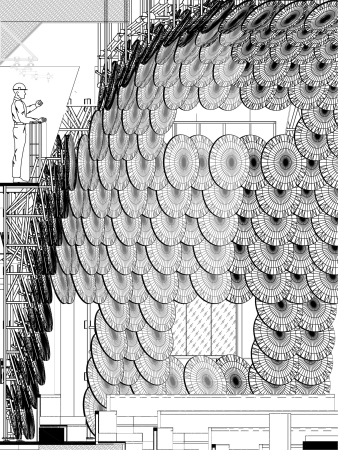So, we are looking at a rare case in the history of contemporary Russian architecture: first, a building constructed according to the design that won a competition; second, with the participation of an international star – this is Kengo Kuma’s first realized project in Russia; and third, the authors being Wowhaus, a prominent Russian firm known for its many public architecture projects.
It’s hard to imagine what this process cost its participants – but the stars definitely aligned here.
We take a close look at the story and the result.
The theater was built in record time – timelines were further compressed during implementation – and closely follows the ideas proposed in the winning design of 2022. It was built almost entirely using Russian contractors and Russian materials. Without exaggeration, this is a new symbol of the city and the Republic of Tatarstan, a building whose function goes far beyond simply housing a set of modern stage venues. We believe that such buildings can transform both people and cities. That is why we are dedicating to it a long and detailed piece, in which we have attempted to cover its architectural features, the broader context, and how the Wowhaus team fought to precisely convey the image.
***
The first play in the Tatar language was written in 1887, and nearly twenty years later, the “Sayyar” troupe – having wandered with its performances through towns and villages of the Russian Empire – finally settled in Kazan and gave its first public productions in their native language. One can only imagine showing those early actors the ice flower into which their theater would relocate after the turn of the millennium.
For more than a century, the theater has served as a vessel for national culture. It quickly received academic status, was named after Galiaskar Kamal, a classic of Tatar drama, and in 1986 was awarded a new building, constructed especially for it on the shores of Lake Kaban – brutalist in character, with national ornamentation on its facades. The building was designed by Munir Agishev and Georgy Gorlyshkov of the Mezencev Central Research and Design Institute for Standard and Experimental Design, and to this day it remains one of the most recognizable and beloved landmarks of Kazan.
Galiaskar Kamal Theater in Kazan
Copyright: © Denis Esakov
A Marker of a New Era
In the 21st century, the theater once again required relocation: the repertoire, the company, and the variety of formats were all growing, while the spaces remained the same. In the 40-meter-long canteen, for instance, meals had to be eaten in shifts; acoustics and logistics left much to be desired. But comfort and technical upgrades were not the only reasons Kazan undertook such a large-scale project.
The importance of the institution is emphasized in one section of the design brief with a quote from Thomas Mann: “Theater is a place where a crowd becomes a people, and a people becomes a nation”. Another section echoes this sentiment: “The construction of a new building for the Kamal Theater is a chance to rethink our own cultural history and to form a de-provincializing space – one that stimulates inquiry and is not confined to the prescriptive narratives of Western/modern exclusivity”. If the old building is a “spatial symbol of the Soviet Tatar nation”, then the new one must serve as “a creative laboratory for self-reflection and a showcase for presenting contemporary Tatar culture”, writes historian Alfrid Bustanov.
The city chose a site for the new theater on the opposite shore of Lake Kaban and announced an international competition.
Kamal Theater in Kazan
Copyright: Photograph © Andrey Artis / courtesy of WOWHAUS
Nationality, Continuity, Inclusivity
The competition was launched in 2021 and attracted 537 submissions from around the world. Eight consortiums advanced to the final round – those who most fully addressed the detailed technical brief, which included not only a long list of required facilities but also the cultural and ideological components mentioned above. Special emphasis was placed on continuity, inclusion, and integration into the urban context.
A series of interim meetings was held for the finalists with the head of the Republic of Tatarstan, the city’s chief architect, and representatives of the theater. The theater prepared a special production to help the designers absorb its spirit and learn the nuances important to locals: the performance featured ordinary people who shared how they get to the theater, why they love it, and how often they attend.
In the end, the team of Wowhaus and Kengo Kuma surpassed other finalists – including Zaha Hadid, Asif Khan, and Coop Himmelb(l)au. According to the theater’s artistic director and jury member Farid Bikchantayev, “this consortium fulfilled every letter of the functional brief” – a result due in large part to Wowhaus. While the Japanese firm was responsible for the conceptual and visual side of the project, the Russian team worked on how to implement it, shaping the spatial layout and stage technology – drawing on experience gained in their work on Praktika and Stanislavsky Electrotheatre. Much of this work was carried out already at the competition stage. The German firm Werner Sobek handled the engineering solutions, while Kazan-based architect German Bakulin assisted with urban planning aspects.
In December 2022, Wowhaus signed the contract for design work, with Tatinvestgrazhdanproekt appointed as general project designer. Werner Sobek later left the consortium, and official collaboration with Kengo Kuma ended in 2023 due to legal restrictions introduced by the Japanese government.
Informal communication, however, continued right up until the opening. And the opening itself came unexpectedly quickly for everyone: in February 2025, the theater hosted Kazanysh – the largest and most prestigious event in its entire history. The builders had been racing to meet the deadline for the BRICS summit, which took place in October 2024: work was carried out year-round, with around 2,000 people simultaneously present on-site. By October, the “flower” had fully unfolded its icy petals, although the interiors were not yet completely finished. Still, the path from concept to first performance took roughly three years. It is emphasized that the compressed timeline in no way affected the conceptual design.
The Ice Flower
At first glance, the image that Kengo Kuma chose may seem somewhat unexpected – or even slightly alien – to Tatarstan’s cultural context. The concept was inspired by ice flowers, a phenomenon occasionally visible on Lake Kaban. It is not a common sight, but a search for “Lake Kaban in winter” easily yields relevant photos. The lake, tied to both historic milestones and legends, is significant for the city – and winter, in many ways, defines Russia. These became the two conceptual anchors. Perhaps Kengo Kuma’s team was also aware that one of the most famous works of Tatar literature is White Flowers by Abdurakhman Absalyamov; there is even a boulevard named after the novel. The image of flowers was also beloved by poet Gabdulla Tukay. Moreover, the ice flower recalls the “desert rose” – a morphologic variety of gypsum that forms in desert sands. This links the theater in Kazan to the Islamic world of the Middle East.
Kamal Theater in Kazan. The competition project, 2022
Copyright: Wowhaus, Kengo Kuma & Associates, Werner Sobek AG, Bakulin Architects
Kamal Theater in Kazan. The facades
Copyright: © Wowhaus
The key to bringing the flower image to life lies in the “ice shards” that form the second layer of the façade. These are designed as triangles of varying sizes, framed in aluminum and filled with custom-made laminated glass (triplex). On the outer surface, the glazing is finished with pressure strips – more delicate structural elements that form a “frosted” pattern. In summer, they resemble leaf veins or a dragonfly’s wing. Nevertheless, the size of the triangles is quite impressive – the longest one stretches up to 80 meters. Yet from the opposite bank of the lake, they appear delicate and slender, like a real crust of ice.
Kamal Theater in Kazan
Copyright: Photograph © Andrey Artis / courtesy of WOWHAUS
Kamal Theater in Kazan
Copyright: Photograph © Andrey Artis / courtesy of WOWHAUS
There are 19 such structures in total. Mounted at different angles, they frame the entire building, turning it into a kind of circular sculpture. Of course, some viewing points are more favorable than others, but all of them were calculated and modeled in advance. One important perspective is from the square in front of the old theater. The surface of the petals, angled differently, creates a reflective effect – whose intensity surprises even the architects: the building looks different not only in various seasons, but also depending on the weather and position of the sun. The triangles can glow deep crimson in sunset light or appear crystal-clear and icy in subzero temperatures and snow.
Kamal Theater in Kazan
Copyright: Photograph © Andrey Artis / courtesy of WOWHAUS
Kamal Theater in Kazan
Copyright: Photograph © Andrey Artis / courtesy of WOWHAUS
The triangles are primarily decorative elements that also provide solar shading for the interior spaces. The “body” of the building consists of multiple fluid volumes forming a complex yet balanced composition, where glazed tiers alternate with solid ones. The glass panels – of required size and with energy-saving coating – as well as the supporting aluminum systems and aluminum cladding panels, were all produced by Russian companies.
Kamal Theater in Kazan
Copyright: Photograph © Andrey Artis / courtesy of WOWHAUS
Kamal Theater in Kazan
Copyright: Photograph © Andrey Artis / courtesy of WOWHAUS
During the design and implementation phases, as theater technology and wind/snow loads were being refined, the team decided to eliminate the glass ceiling in the circular hall, reduce the amount of public space on the roof, and abandon the amphitheater-style staircase that would have led up to it. Any adjustments that affected the visual concept were discussed by the Wowhaus team with their Japanese colleagues. Compared to the initial renderings, the sharpness of the triangles has been softened somewhat – although even in this version, it can cause concern: after Kazanysh, photos circulated showing a triangle edge positioned at pedestrian height in a walkway, which had to be marked off with red tape. The architects had proposed using metal pressure strips for marking, and suggested an alternative landscaping solution for the triangle near the service entrance. However, it was those particular measures that were not implemented due to time constraints.
The Treasures of Syuyumbike
The idea of a striking contrast between the cold, translucent outer shell and the warm, richly ornamented interior also came from Kengo Kuma’s office. The ornamentation – visible even from the outside – covers the curved walls that separate the lobbies of the halls from the central vestibule. All four halls are located on the same level, yet each has its own character.
It turned out that the red color seen in the competition renderings is not very close to Tatar cultural traditions. The architects at Wowhaus invited People’s Artist of the Republic of Tatarstan Nailya Kumysnikova to develop the decorative concept. Together with designer Jamil Fedotov, she proposed using gold and silver surfaces to transform the lobby into a treasure chamber of Syuyumbike, the last queen of the Kazan Khanate. According to legend, her treasury was hidden at the bottom of Lake Kaban, and many have tried to find it. When the finished elements were brought to the site, they truly resembled heaps of coins.
Kamal Theater in Kazan
Copyright: Photograph © Wowhaus
For the lobby and each of the halls, Nailya Kumysnikova developed unique ornament patterns and compositions. The lobby was filled with “gold” and “silver” elements made of stainless steel, reminiscent of traditional women’s jewelry. The architects designed multilayered wall panels to house these elements, embedding them with lighting equipped with dimmers that adjust brightness, color temperature, and hue. In the evening or on cloudy days, the warm glow is irresistibly inviting. The “sails” on the ceiling appear to be wooden, but in fact they are also made of metal – to comply with fire safety regulations.
The Major Hall, with two balconies and three tiers of lobby space, seats 771 people and has a solemnly grand appearance, though it is executed in a rather minimalist style. The arched vaults, soft curving forms, and subdued color palette evoke mosque architecture. The main stage is finished in light oak, while the door panels are adorned with a subtle ornamental pattern.
Kamal Theater in Kazan
Copyright: Photograph © Andrey Artis / courtesy of WOWHAUS
Kamal Theater in Kazan
Copyright: Photograph © Andrey Artis / courtesy of WOWHAUS
Kamal Theater in Kazan
Copyright: Photograph © Andrey Artis / courtesy of WOWHAUS
The Eastern Hall, seating 241, has a circular shape – challenging for acoustics – and rich décor that is unusual for a modern stage. The walls are decorated with “coins” inspired by Tatar chainmail, pectoral ornaments, or the scales of a fish from that very same lake. The coin design posed a challenge: metal was not an option due to acoustic considerations. In the end, the architects and contractors chose gypsum. Each convex coin consists of a metal frame, with gypsum as the primary material, and a metallic paint applied to the surface. The result is essentially handcrafted: 1,200 coins, each weighing 40 kilograms, were cast at a small factory in Kazan. The convex shape reflects sound, thereby enhancing the acoustics.
Kamal Theater in Kazan
Copyright: Photograph © Andrey Artis / courtesy of WOWHAUS
Kamal Theater in Kazan
Copyright: Photograph © Andrey Artis / courtesy of WOWHAUS
The Universal Hall is a multifunctional black box space where the audience is completely focused on the stage, and the director is free to experiment. The hall can be adapted to various formats and accommodates between 100 and 274 spectators.
Kamal Theater in Kazan
Copyright: Photograph © Andrey Artis / courtesy of WOWHAUS
The Chamber Hall, with a window facing the embankment, is designed for lectures, concerts, artist talks, and other events. Altogether, the four halls can host 1,347 audience members.
Kamal Theater in Kazan
Copyright: Photograph © Andrey Artis / courtesy of WOWHAUSn
The Actor’s House
The architects gave just as much thought to the impression the building would make on the actors and everyone involved in creating performances. It would be wrong to say that all efforts were concentrated only on dazzling halls and lobbies.
The audience and performer flows are separated. The troupe has at its disposal half – or even more – of the entire complex. The musicians’ dressing rooms are located in the basement, while the orchestra’s rehearsal room, with a large panoramic window overlooking Lake Kaban, is placed on the fourth floor. Part of the ground floor houses the scenery workshop, from which sets are loaded directly into the main halls, as well as a large rehearsal room – a full replica of the main stage. Next to it are the dressing rooms for honored artists, so that no force majeure – such as a malfunctioning elevator – could prevent a star from reaching the stage.
Kamal Theater in Kazan. The competition project, 2022
Copyright: Wowhaus, Kengo Kuma & Associates, Werner Sobek AG, Bakulin Architects
Kamal Theater in Kazan. The competition project, 2022
Copyright: Wowhaus, Kengo Kuma & Associates, Werner Sobek AG, Bakulin Architects
The entire third floor is dedicated to the theater. In addition to rehearsal rooms, dressing rooms, and offices, there is a cafeteria with panoramic views of the lake and the old building. A truly luxurious, spacious, and light-filled canteen.
There is also a play area where actors can leave their children during rehearsals and performances. Some of the spaces are available for use by theater studios. From the third floor, an elevator provides direct backstage access to the performance halls.
Kamal Theater in Kazan
Copyright: Photograph © Andrey Artis / courtesy of WOWHAUS
More Than a Theater
According to the original concept, the theater is intended to function as an urban public space, open to visitors throughout the day – you don’t need a ticket to enter. The turnstiles are placed deep inside, just before the entrances to the halls.
A broad staircase, clearly visible behind the main entrance, creates a sense of openness. You can walk in from Khadi Taktash Street, grab a coffee in a stylish cup at the Kosh buffet, and head out to the embankment. You can pause by the panoramic windows, visit a lobby exhibition, drop off your child at the kids’ club, or spend time working in the coworking area. Yet another option: go up to the rooftop or visit the Sayyar restaurant that offers scenic views.
That said, the whole system is still running below full capacity – it’s currently going through an adjustment phase.
Kamal Theater in Kazan. The competition project, 2022
Copyright: Wowhaus, Kengo Kuma & Associates, Werner Sobek AG, Bakulin Architects
A distinctive environment is also taking shape around the theater – part of the embankment improvement plan designed by Turenscape and MAParchitects, with a stop along the circular route around the lake. Landscaping of the surrounding parks is being carried out by Arkhdesant and Park-Service in collaboration and friendly coordination with Wowhaus. The theater garden has already been completed, and the floodplain forest has been restored. Nearby, a new metro station is planned, along with the renovation of the old candle factory – a project beautifully designed by the Wall Architects. The areas behind the theater, which currently look modest in comparison, will likely evolve as well – at the very least, through façade renovation.
Kamal Theater in Kazan
Copyright: Photograph © Andrey Artis / courtesy of WOWHAUS
Kamal Theater in Kazan
Copyright: Photograph © Andrey Artis / courtesy of WOWHAUS
You can tour the theater’s interior spaces by signing up for a guided visit. Even better – this is something we ourselves dream of – is to buy a ticket to a performance. And performances are in high demand: the theater has become a sought-after venue for major cultural events, hosting festivals, forums, and public celebrations.
Kamal Theater in Kazan
Copyright: Photograph © Andrey Artis / courtesy of WOWHAUS
In other words, the new Kamal Theater is a vibrant public center and event venue – even at the highest level. Much is said today about the multifunctionality and social role of modern libraries, museums, and theaters, but this ambition, often at odds with safety requirements and market constraints, rarely comes to fruition. Cases like this remain uncommon. Which is why we will be watching with interest the evolution of the Kamal Theater – this rare ice flower frozen in glass, with a warm “soul” inside.





